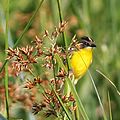| Pseudocolopteryx | |
|---|---|
 | |
| Crested doradito (Pseudocolopteryx sclateri) | |
| Scientific classification | |
| Kingdom: | Animalia |
| Phylum: | Chordata |
| Class: | Aves |
| Order: | Passeriformes |
| Family: | Tyrannidae |
| Genus: | Pseudocolopteryx Lillo, 1905 |
| Type species | |
| Pseudocolopteryx dinellianus [1] Lillo, 1905 | |
| Species | |
see text | |
Pseudocolopteryx is a genus of bird in the family Tyrannidae. They are found in marshy habitats in South America. All have yellow underparts.





